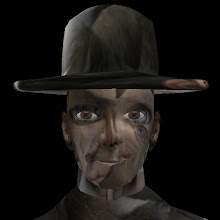"Where the digital proposes the perfect finite conditions for a perfect existence regardless of matter, (as for example in the human genome project), in the postdigital analogue (as for example in the ironies of genetic and wet biological art) human consciousness is regarded as almost infinitely malleable, able to shape its identity in response to local (and technological) conditions aware all the time of the range of possibilities (digital and analogue) that are not developed." (Punt, 2001)
Excuse me whilst I go off on some uncertain tangents. There is a high probability that I am about to talk poppycock, but as Theodore Roosevelt said, “The only man who never makes a mistake is the man who never does anything.”
A few years ago, I spent a lot of time downloading chunks of DNA from the National Center for Biotechnology Information's Genebank, and wrote some code to visualise them. My basic idea was to read the As, Gs, Ts and Cs, and move a pixel either up, down, left or right, tracing a line. Different DNA chunks drew different squiggles. They looked like they made some sort of sense, which of course they did, and I got particularly obsessed with comparing mitochondria sequences from different organisms. You can see some of this stuff on my old site:
cubistscarborough.com/iantruelove
Along with every other living organism that has ever existed, we are digital to our very core. We are code. Our existence is encoded in a very long sequence of As, Ts, Cs and Gs. We are Data, Not Animals. But, of course, we are animals, not data. We are fuzzy and vague and interesting. We are wet and unimaginably complex. We are a whole, conscious being that exists over time. We are not digital. We are postdigital.
Not really sure where that one is going, but it might give me an excuse to do some more DNA art. Lets move onto some different poppycock.
The original article that the opening quote is taken from also mentions Gene Youngblood, who reminded us 25 years ago that, "the computer translates the continuous phenomena of the world into discrete units." The inescapable reduction of the homogenous whole into separate pieces, through the process of digitisation, might provide a useful metaphor for education. One of the things that struck a chord with me when I watched Liz Coleman's talk last week was her criticism of the fragmentation of education. I have rallied against the tyranny of the module as the dominant unit of learning ever since it was imposed on us. This quantising of education, splitting learning into smaller and smaller units, serves the inspectors, the financiers and the timetable police very well. It does not serve the whole learner – a complex human being – very well at all. The reason I dislike (and refuse to use) VLEs is primarily because they reinforce and often impose this modular approach. Perhaps it is this sort of 'digitisation' of education that postdigitalism might react against. To re-appropriate the words of Peter Weibel as detailed in Punt's article, education should follow the analogical principles of 'similarity, congruency and continuity', and reject the 'discontinuous, non homogenous elements' as characterised by the digital, and played out in the modular system. The 3 year long, holistic view of learning as promoted by Professor Graham Gibbs and others aligns with this newly invented version of postdigitalism. Taking this line of reasoning to its logical conclusion, the postdigital learner is the lifelong learner, the informal and formal learner, the whole human learner. Not a learner who has been captured, cut, and pasted into easily measurable and inspectable chunks, but an integrated learner, inseparable from the world that they are connected to. In this parallel postdigital universe, I'm allowed to get excited about Google Wave, as it may potentially provide an excellent way to support the postdigital learner.
I think I'm rambling a bit now. I'll stop.
Punt, M. (2001) Human Consciousness and the Postdigital Analogue. Leonardo 35 (2), 2002. pp119-120

No comments:
Post a Comment